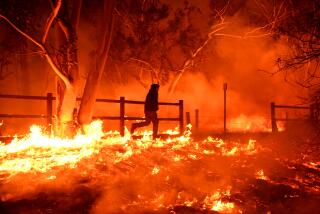Fire-Damaged San Onofre Reactor May Not Be Back Online Till June
- Share via
Nuclear power officials said Wednesday that it will cost tens of millions of dollars, and take months more work than originally thought, to fix a reactor at the San Onofre power plant that has been offline since a February fire.
The shutdown at San Onofre is the largest of the many generator failures that have contributed to California’s power crisis--so large that some say this week’s blackouts could have been prevented if it had not occurred.
The biggest gaps between demand and supply statewide were 800 megawatts Monday and 500 megawatts Tuesday, according to the California Independent System Operator, which runs the statewide power grid. San Onofre’s Unit III, which can generate 1,100 megawatts, or enough for 825,000 homes in warm weather, has been shut down since an electrical fire Feb. 3.
“If Unit III had been up and running . . . that 1,100 megawatts may have meant the difference,” said Michael Shames, director of the Utility Consumers’ Action Network in San Diego. “Ouch. It’s one of the more costly mistakes made by a utility in recent history.”
A team of inspectors from the Nuclear Regulatory Commission said Wednesday that the fire was not caused by human error, but occurred after an electrical breaker failed, causing a short circuit.
But NRC officials also said that the firefighting response was delayed because of an improperly trained employee, and that alarm systems in the control room failed. They said those mishaps did not make damage worse or jeopardize the public’s health.
A written report is expected in a month, and no administrative action or fines are expected, said Charles S. Marschall, an NRC reactor branch official.
Southern California Edison officials conceded that all three of the system’s lubricating systems failed, causing extensive damage to the turbine, which produces electricity.
A 200-ton rotor has been shipped by rail to Richmond, Va., for repairs and is expected back in mid-April.
Edison officials initially said the unit would be fixed several weeks after the fire. They now say it should be fixed by mid-June--in time for peak summer energy demand.
“Nobody more than Edison wants to be back online to help out Southern California in meeting its energy needs, but the repairs have to be done right,” said Ray Golden, plant spokesman. “We are working 24-7 to get it back online. We will have both units operating through the summer.”
Plant officials said they do not know the final price tag for repairs, beyond an estimate of “tens of millions.” Golden said that except for a $2.5-million deductible, the utility’s insurance will cover damage to the turbine.
The downed reactor is also costing Edison $500,000 to $600,000 a day in lost revenue. Another San Onofre reactor remains in operation, and a third is being dismantled.
Starting April 29, the utility’s insurance will put $3.5 million aside every week until the reactor begins operating again. The money is intended to compensate Edison customers for the lost energy, though Golden said the company has not determined how the funds will be disbursed.
“I can absolutely say that it’s not going to shareholders or the corporation,” he said.
The California Public Utilities Commission will make the final decision on what happens with the money. Options range from crediting the utility’s 4.5 million customers’ bills to reimbursing the state, which has had to buy energy at exorbitant prices to make up for the shortfall.
San Onofre is not the only power plant with maintenance woes. California this week lost 12,000 megawatts because of plant repairs--including 7,000 megawatts lost suddenly because of unscheduled maintenance at dozens of generating stations.
The San Onofre outage was the largest, although the state lost almost as much from equipment breakdowns at power plants in Ormond Beach and Long Beach.
Operators of the power plants say outages are more common now because they have run their aging plants at record levels to feed California’s appetite for energy.
Just before the San Onofre fire, operators had refueled Unit III in a record 32 days. Refueling normally takes more than 40 days, plant officials said. Twelve hours after they brought it back online, though, the fire broke out.
Nuclear regulators and plant officials said the speedy refueling had nothing to do with the fire or the failed alarm or lubrication systems.
Times staff writer Nicholas Riccardi contributed to this story.
More to Read
Sign up for Essential California
The most important California stories and recommendations in your inbox every morning.
You may occasionally receive promotional content from the Los Angeles Times.














